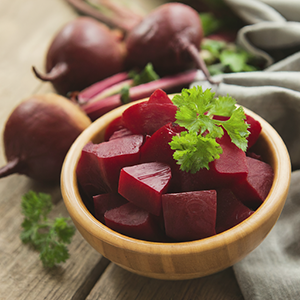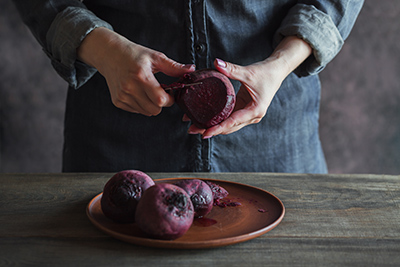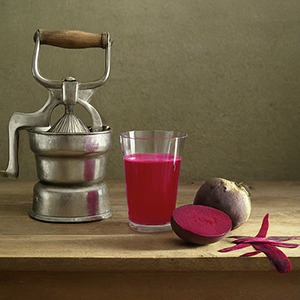Contents

Let’s learn about this superfood before getting into the many red beet health benefits. The blood-red color of beets gives a positive note to potato dishes and salads. Could it be that red beets indeed comprise blood? Individuals who have passed blood-red urine or feces a short time after eating beets might think so. What a fright! But it is not blood but a color given to this plant called betacyanin.
According to a study at the University of Sheffield, 10 to 14 percent of the population experiences red urine or feces after eating beets. This is more common in people with iron deficiency or complications with intestinal assimilation of iron. Therefore, if one is shocked by red elimination, one should be thankful that this plant has cautioned about a lack of iron or digestive conditions.
Still, one should not worry overly: Beets not only warn of the trouble, but aid in its solution, thanks to their anti-anemic and normalizing impacts on the digestive system.

Red Beet Health Benefits
Carbohydrates (sugars) such as fructose and saccharose lead in beets’ composition. These can reach 10 percent of their weight, making the red beet one of the most extraordinary sugar-rich vegetables, exceeded only by other types of beets. These are beets’ most notable characteristics:
Anti-anemic—The anti-anemic action of red beets is well known and has been described by Doctor Schneider, among others. Their iron content and vitamin C, which facilitates mineral absorption, are reasonable but do not clarify red beets’ anti-anemic effect. It is probably some unknown component that promotes hematopoiesis (production of blood cells in the bone marrow).
Drinking fifty to one hundred ml of raw, freshly made beet juice before meals twice daily provides the most excellent anti-anemic effect. This is especially revealed when the patient does not respond well to iron therapy, which is the anemia case caused by low blood creation in the bone marrow (hypoplastic anemia).
Alkalizer – Beet’s high levels of mineral salts, mainly magnesium, calcium, and potassium, make clear their alkalizing effect on the blood. They are highly proposed in case of gout, heightened uric acid levels in the blood, low vegetable, high-fat diet.
Hypolipidemic—Beetroot contains large amounts of vegetable fiber, which assists intestinal action and lessens blood cholesterol levels by lowering the amount absorbed in the intestine. A study by the University of Minnesota showed that 30 mg of beet fiber daily over three weeks reduced total cholesterol by approximately 10 percent of its initial value. This decline was more substantial than other vegetable fibers, such as wheat bran. It is highly recommended, then, that red beet frequently be included in the diet of individuals wishing to reduce cholesterol levels.

Mild laxative – due to its fiber content.
Anticarcinogen – Doctor Schneider refers to various events in Hungary and Germany in which cancerous tumors decreased or were destroyed by dispensing a daily dose of 250 grams of shredded beets or 300 to 500 ml of juice. These results were generated even when the juice was boiled and concentrated, making it more bearable to the stomach, which implies that no matter what the anticarcinogenic substance is, it is heat resilient.
The studies that are in the process today concerning the phytochemicals in plant-based foods may confirm these experiences and identify the anticarcinogen in red beets.
Sugar Beet
Sugar beets are a botanical variety (‘Beta vulgaris’ L. ssp. ‘vulgaris’ var. ‘altissima’) rich in sugars (saccharose) but not appropriate for direct consumption. The juice of the sugar beet contains up to 20 percent saccharose, so it is cultivated for industrial production of white sugar (saccharose).
Red Beets Scientific Facts
- Scientific name: Beta vulgaris L. var. conditiva.
- French: Betterave.
- Spanish: Remolacha, Remolacha de mesa, Remolacha colorada.
- German: Rote Bete.
- Description: A herbaceous plant of the botanical family Chenopodiaceae and the tuberous root of the red beet.
- Environment: Beets are cultivated throughout Europe and North America. They adapt well to cold climates.

How to use and Prepare Red Beets
- Fresh juice—Beet juice is unpleasant, so it can be sweetened with honey or mixed with other juices to make it more appealing. Avoid indigestion by drinking no more than 50-100 ml.
- Great raw – Beets prepared this way may be dressed in lemon and oil.
- Boiled—Cooking beets makes them more digestible. They ought to be boiled for at least one hour. Peeling them is simpler if plunged into cold water while still hot.
DISCLAIMER: All content on this website is presented solely for educational and informational objectives. Do not rely on the information provided as a replacement for advice, diagnosis, or treatment from a qualified medical expert. If you are pregnant, nursing, or have any preexisting medical concerns, talk to your doctor before using any herbal or natural medicines.
REFERENCES
- George D. Pamplona-Roger, M.D. “Encyclopedia of Foods and Their Healing Power.” George D. Pamplona-Roger, M.D. Encyclopedia of Foods and Their Healing Power. Trans. Annette Melgosa. Vol. 2. Chai Wan: Editorial Safeliz, 2005. 122, 123. Print. [red beet health benefits]
- Anti-Inflammatory Properties of Dietary Nitrate – National Institutes of Health (NIH)
- Dietary Guidelines for Americans 2020-2025 – The U.S. Department of Health and Human Services and U.S. Department of Agriculture
Last update on 2025-06-03 / Affiliate links / Images from Amazon Product Advertising API





